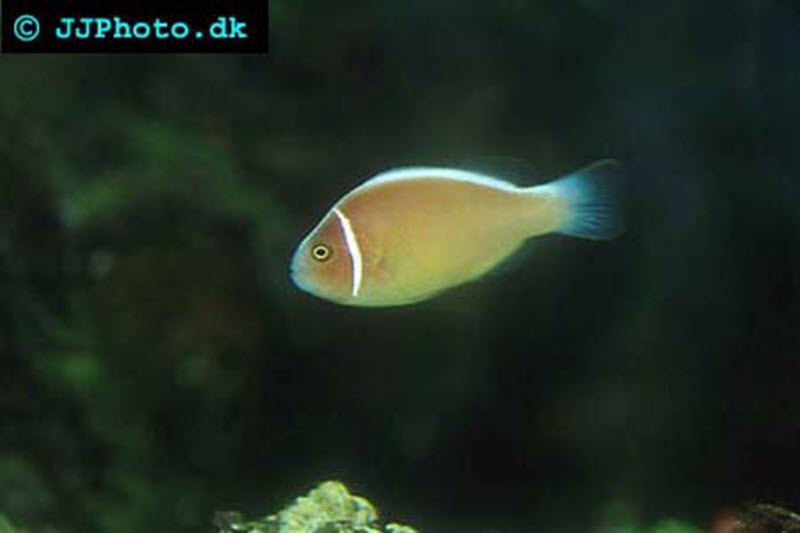Pink Skunk Clownfish – Amphipirion perideraion
Common name: Pink Skunk Clownfish, Pink Clownfish, Pink Anemonefish, Pink Skunk Anemonefish.
Scientific name: Amphipirion perideraion
Max size:4 in / 10 cm

Copyright www.jjphoto.dk
The Pink skunk clown fish is part of a group of clownfish that are all called skunk clown fishes. The name is not hard to understand when you see a skunk clownfish; they have a white band running across the upper part of the entire body. The pink skunk clownfish has, as the name suggests, a pink to yellowish base color on the body. There is a characteristic white “skunk” field on top of the body and a narrow vertical white stripe runs the height of the fish just in front of the pelvic fin.
This clownfish is commonly available in the pet trade and both aquarium bred and wild caught specimens can be found for sale. I recommend that you buy aquarium raised specimen whenever possible to ease the strain on the wild populations. The collecting of clown fish for the pet trade is threatening clownfish populations in some locations. An added bonus for doing the right thing is that aquarium bred specimens are hardier and easier to care fore. Beginners should never buy wild caught specimens.
The Pink skunk fish is a relatively hardy species and an aquarium bred specimens can be a suitable beginner fish for those who want to try to keeping marine fish as it is cheap as well. This species thrives without an anemone which makes it an even better choice for those who want to keep their first saltwater fish.
The Pink skunk clownfish originates from the eastern Indian Ocean and western Pacific Ocean and is common throughout the Indo-Australian Archipelago.
The Pink skunk clownfish is friendly towards most fish except towards other skunk clownfish species and other Pink skunk clownfish. They are rather timid towards other species and should therefore only be kept with friendly fish.
Aquarium setup
The Pink skunk clownfish can be kept in a 20 gallon / 90 L aquarium but if you want to keep a group of them I recommend a larger aquarium as they can be quite aggressive towards each other and specimens sometimes need space to flee and hide.
The aquarium should be decorated with plenty of hiding places. This species does best in a reef aquarium although they can be kept in “fish only” tanks. The Pink skunk clownfish is reef safe. As all clown fish they like an aquarium with a lot of live rock with algae growing on it. They don’t need anemones and do as earlier stated in fact thrive and breed without one. If you want to keep anemones with them to observe their natural behavior darting in an out of anemones you should ideally choose one of the following species: Heteractis magnifica, H. crispa, Macrodactyla doreensis, or Stichodactyla gigantean.They do however adapt to other anemone species as well in aquariums.
Feeding pink skunk clownfish
The Pink skunk clownfish is just like most other clownfish species easy to feed. They are omnivores and prefer a mix of meaty food and vegetables such as algae. They willingly accept marine flake food and can be kept and bred on a diet consisting of high quality flakes. I do however recommend a more varied diet consisting of high quality flakes as well as a variety of small frozen foods. They like to eat algae but are less prone to it than many other clownfish species. If they are kept in a reef aquarium with a lot of live rock and healthy algae growth they can be fed more sparsely and be given a smaller amount of vegetables than what they would need in an aquarium without algae. Feed this fish 2-3 times a day.
Breeding pink skunk clownfish
The male Pink skunk clownfish are much smaller than the females. This species is regularly bred by hobby fish keepers. It is also bred on a larger scale by commercial breeders for the pet fish trade. They are not very hard to breed and if you have a suitable pair and patience you have good chances of succeeding to breed this species. They can be breed without an anemone present as long as a suitable substrate is provided. If you want to find out more on how to breed clown fish I recommend that you read our article about breeding clownfish. The fry are small and more sensitive of poor water quality and the adult fish. They need to be provided with very small food as soon as they are free swimming. Feed the fry 5-8 times a day (once every 2 hours) if possible.